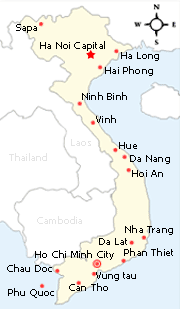|
History and aura shroud Cam Mountain
Next to the temple, Cam Mountain has beautiful bamboo forests and is home to a large cave with looming stalactites. Cam Mountain where the ancient Truc (Ivory Bamboo) Temple is located, is covered by lively green forests of bamboo. The lion-shaped mountain is in Kim Bang District in the northern province of Ha Nam, 8km from Phu Ly Town, the province’s centre. The ancient temple on the legendary mountain has a miraculous cave attracting pilgrims and tourists. History and legend The mountain was covered in ivory bamboo for hundreds of years. Do Chi Vien, 63, a member of the temple’s management board, recounts the history of the temple hidden in the bamboo’s green shadow. General Ly Thuong Kiet (1019-1105) commanded a naval fleet to fight against the enemy in 1089 on the Day River. When the troops were near the mountain, suddenly a hard wind blew the regiment’s signal flag to the mountain’s peak. Kiet took this as a sign and lead the troops to the mountain, lit incense for the gods and prayed for victory. He ended up being victorious. Once again, he held a ceremony at the mountain to express gratitude to the gods, and hosted a feast for the troops and the villagers. General Kiet considered the mountain to be holy and banned anyone from violating it in any way. Since then, he named the mountain Cam (Banned). The villagers set up a temple to commemorate the victory and worship him once he died. The temple was nestled amongst the ivory bamboo bushes on the mountainside and so was named after the tree. After hundreds of years, the wooden temple has been restored many times, but the ancient characters and carved art on the doors and roof were maintained. Every year, the villagers hold a festival in the lunar month of January to remember General Kiet’s festival of long ago. The one-month festival includes many folk games such as cock fighting, wrestling, tug of war and boat racing. Dancing and the singing of folk songs are the highlight of the festival. A troupe of 30 amateur artists perform in the temple’s courtyard. Young virgins are chosen carefully for this honour. Natural wonders Next to the temple, Cam Mountain is really beautiful with its bamboo forest. It hosts a large cave with unique stalactites. The mountain has not been developed and has retained its primordial beauty. Every year since 1991, the site has welcomed about 24,000 tourists, according to Vien. With the caves inside the mountain, the mountain has been given another name, Ngu Dong (Five Caves) Mountain. All five caves share a common entrance. The mouth leads tourists to a 400m-long cavern containing five rooms split naturally by stalactites. Under yellow light, a curious world appears in the caves as Vien narrates about the caves and the figures that appear in the stalactites. A statue of General Kiet is placed majestically between a stone tiger and an eagle at the entrance to the cave that Vien says are natural, not human-made. I’m not different from other tourists. When I see the stripiness on the tiger and feather on the eagle, I am amazed that water spent thousands of years to create them. Vien pointed out several special features of the stalactites: a stone flag seems to be flying on the cave’s ceiling; a war drum is below with the soldier appointed to beat the drum relaxing next to it with his head on his arm. Not far from the soldier, a woman carrying her baby looks for her husband who went into battle. Two other stalactites look like a couple’s hands which are clapsed as the man says farewell to his wife on his way off to war. The cave gathers the four supernatural creatures of dragon, phoenix, kylin and tortoise, symbols of sacredness, power, longevity and fortune in Vietnamese culture. Located in a charming natural area, the spot wows tourists with its beauty and ties to history. Dinh Van Thuan, a local man, says that he is proud of the tourist area. "While Ha Nam Province hasn’t developed its tourism sector, such precious destinations like the Truc Temple and the Five Caves should be preserved and invested in to attract more and more tourists to the area." This beautiful spot, with a total area of 2,042ha, will be invested in from now to 2020, according to Vu Manh Diem, Kim Bang District’s Culture and Information officer. Two hotels will be constructed to welcome tourists, and the temple’s management board will carve a bronze bell weighing 100 tonnes. It’s expected to be the largest bell in Viet Nam. VietNamNet/VNS Other news for Tuesday 10 November, 2009
View all news for Tuesday 10 November, 2009 on one page News for Thursday 05 November, 2009
View all news for Thursday 05 November, 2009 on one page Recent News
|










